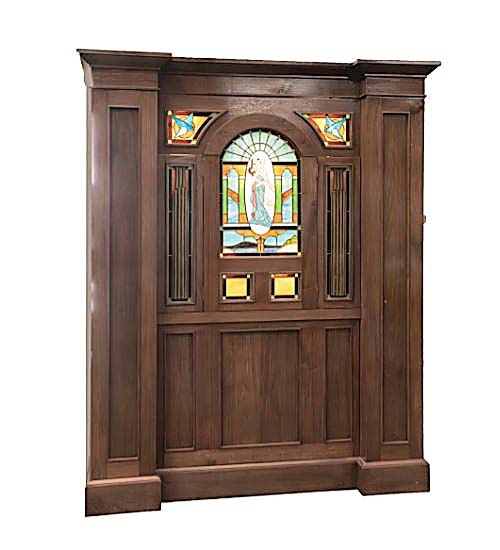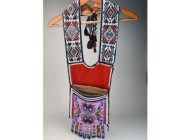
A Hupfeld Phonoliszt-Violina Piano-Violin Model “A” hit a high note, leading the sale at $221,400 on the third day. The device, produced in Leipzig, Germany, circa 1912, featured each violin playing one string, with a bow of 1,350 strands of horsehair and a series of complex mechanisms to mimic violin expression, bowing, vibrato, staccato, accent and other nuances, as well as piano expression.
Review by W.A. Demers
LAS VEGAS, NEV. — On October 17-19, Morphy’s Auctions presented an arcade-worthy selection of antique European and American music, slot and fortune-telling machines. The sale offered 1,913 lots that cashed out at $4.2 million. The company declined to provide a sell-through rate or total number of registered bidders. Les Jones, the firm’s chief operating officer and director of marketing, however, said that there were close to 100 people in the gallery on the third day. “A lot of the lots went to the floor,” he said.
Cataloged as “the most successful automatic violin and piano playing machine ever made,” a Hupfeld Phonoliszt-Violina Piano-Violin Model “A” hit a crescendo of $221,400 on the third day. Produced in Leipzig, Germany, circa 1912, the device featured each violin playing one string, with a bow of 1,350 strands of horsehair, and devices to maintain constant tension despite humidity changes. A series of complex mechanisms reproduced violin expression, bowing, vibrato, staccato, accent and other nuances, as well as piano expression, duplicating the playing of accomplished musicians. Ludwig Hupfeld was quoted, according to catalog notes, saying, “The most admirable quality of the Phonoliszt-Violina is its soul, thus the most important factor in violin playing has been accomplished to give soul to this self-playing violin.” It was purchased from a restaurant in France and acquired by Jasper Sanfilippo in 1983. The consignor acquired it from Sanfilippo Place de la Musique in 2012 and it was restored by Reblitz Restorations in Colorado Springs, Colo., in 1986, and 2014.

A robust price of $135,300 was posted for this circa 1904 Caille Bros (Detroit) roulette 5¢ floor-model slot with a seven-way roulette wheel payout. Housed in a rare Honduran mahogany cabinet with elaborate copper-flashed and plated iron castings, it was fully restored and, according to the catalog, one of the finest coin-op examples the firm had ever seen.
Slot machines brought robust prices, including a circa 1904 Caille Bros (Detroit) roulette 5¢ floor-model slot with a seven-way roulette wheel payout. The machine featured a rare Honduran mahogany cabinet with elaborate copper-flashed and plated iron castings. Fully restored, it was, according to the catalog, one of the finest coin-op examples they had ever seen. From a 30-year private collection, it went out at $135,300.
A Coinola Model SO (for Super Orchestrion) plucked $90,000. Circa 1920 and post-Prohibition, it was made by the Operators Piano Company, Chicago, Ill., the firm’s largest keyboard-less orchestrion. Approximately 50 are believed to have been made. Catalog notes stated that it may have originally been owned by a Chicago mobster, acquired by the Nickelodeon Tavern in Chicago Heights in 1965, and to a Wisconsin collector in 1985. It was fully restored by the current consignor and has sat in a climate-controlled home since the completion of its restoration in 2015.

Circa 1920 and post-Prohibition, a Coinola Model SO (for Super Orchestrion) earned $90,000. Approximately 50 are believed to have been made by the Operators Piano Company, Chicago, Ill.
Going out at $49,200 was a circa 1920 Mills Deluxe Violano-Virtuoso, comprising two violins that play simultaneously. The idea for a machine that would play violin duets came from a young man named Henry K. Sandell who in 1904 joined the Mills Novelty Company. His first project for the Mills Co., was to perfect an automatic violin-playing machine, and in 1905 or 1906, Mills Novelty Company launched the “Automatic Virtuoso” and the Mills Violano-Virtuoso was born, with many future design variations to come. This example of the Deluxe Violano-Virtuoso was housed in a beautifully finished Brazilian mahogany cabinet and was fully restored.

This circa 1920 Mills Deluxe Violano-Virtuoso, comprising two violins that play simultaneously, found a buyer at $49,200.
Prices given include the buyer’s premium as stated by the auction house. The firm’s sales head back to Las Vegas on December 5-7 for another coin-op and advertising sale. For information, 877-968-8880 www.morphyauctions.com.




